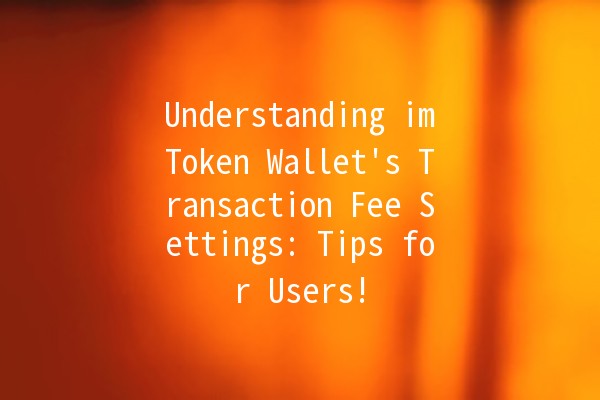The imToken wallet has gained significant popularity as one of the leading cryptocurrency wallets, allowing users to manage their digital assets effortlessly. However, many users often have questions about transaction fees associated with the imToken wallet. Understanding how to set and manage these fees is crucial for optimizing your transactions and ensuring their success. This article dives into various aspects of transaction fee settings in the imToken wallet, providing practical tips and insights for users looking to enhance their experience.
Transaction fees are the costs associated with processing transactions on the blockchain. When you send or receive cryptocurrencies, a fee is often required to compensate miners for their work in confirming and processing the transaction. In the case of imToken, users have the flexibility to manage their transaction fees, which can impact transaction speed and success.
Setting the appropriate transaction fee is crucial for several reasons:

Here are five essential productivityenhancing tips for effectively managing transaction fees in your imToken wallet:
Before sending a transaction, it's vital to assess the current network conditions. Websites like ETH Gas Station provide realtime fee recommendations based on network congestion. This research helps you decide whether to set a higher or lower fee.
Example: If the network is experiencing high congestion, you might consider setting a fee above the recommended average to ensure faster processing.
imToken wallet features a builtin fee recommendation tool. When making a transaction, take advantage of this tool to understand the suggested fee based on current network conditions.
Example: If you're transferring tokens during a period of low network activity, the tool might suggest a lower fee, which can save you money while still ensuring your transaction is processed.
For urgent transactions, where timing is critical (e.g., buying a token at a sudden dip), consider manually setting a higher fee to expedite processing. The imToken wallet allows users to customize fees based on their immediate needs.
Example: If you expect a market shift and want to secure a purchase, increase your transaction fee to speed up confirmation.
Don't hesitate to experiment with different fee amounts. Over time, you will get a better feel for how various fees affect processing times during different conditions.
Example: Test sending small amounts with varying fees to analyze how quickly each transaction is confirmed. This practice helps you find the optimal fee for your future transactions.
Blockchain networks frequently evolve, and transaction fee structures can change. Follow community updates, blogs, or forums related to imToken and Ethereum to stay informed. Understanding potential changes can affect your fee strategy.
Example: If a new scaling solution is announced, it might lead to lower fees in the near future, allowing you to save on costs.
Setting transaction fees in the imToken wallet is straightforward. Follow these steps to ensure your transactions are optimized:
Transaction fees are primarily based on network congestion and the size of the transaction in bytes. The higher the demand to process transactions, the higher the fees are likely to be. imToken provides users with recommendations that reflect current network conditions.
While you can set a lower fee than what is recommended, this may result in your transaction being delayed or not processed at all, especially during periods of high traffic. It's a calculated risk, and understanding the network conditions can help in making a better decision.
If the fee is too low, your transaction might not get picked up by miners, leading to delays. In some cases, it may end up in a backlog depending on network factors. If you notice an unusually long confirmation time, you may need to consider resubmitting the transaction with a higher fee.
Once your transaction is submitted and confirmed on the blockchain, you cannot change the fee. If you want to adjust fees, you will need to cancel the transaction if it hasn't been picked up yet and then resend it with a new fee.
Generally, the transaction fees for sending ERC20 tokens are similar to those for Ether (ETH) because both transactions are processed on the Ethereum blockchain. However, complexities associated with ERC20 tokens may sometimes result in slightly higher fees.
To maintain low transaction costs, consider sending transactions during offpeak hours when the network is less congested. Additionally, monitor recommended fees and adjust your transaction settings accordingly. You can also consolidate transactions when possible.
By understanding and managing transaction fees in the imToken wallet, you can enhance your crypto experience and make the most of every transaction. Whether you’ve just begun exploring the world of digital assets or are a seasoned trader, mastering these settings is a valuable skill for any cryptocurrency user. Happy transacting!